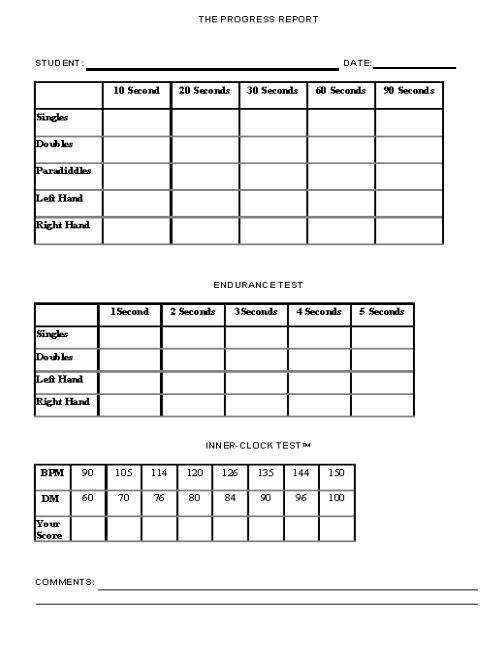
The process starts with The Progress Report as seen below. The Progress Report can be designed to track the progress of any objective, including all of the rudiments. The basic Progress Report enclosed was designed to track the student's progress of the Single Stroke Roll, Double Stroke Roll, Single Paradiddles, the Right and Left Hand individually, and the INNER-CLOCK TEST™. The basic Report is designed using three increments, 10 seconds, 30 seconds and 60 seconds
Once the student has learned his/her singles, doubles, paradiddles and right and left-hand taps, he/she is ready for the Drumometer. The first session with the Drumometer becomes the starting point for each student and is dated and recorded as such. Each student starts at 10 seconds and is asked to play a single stroke roll. At the end of 10 seconds the Drumometer stops and the amount of strokes are captured and recorded. Next, the student runs his/her doubles for 10 seconds and the paradiddles for ten seconds. The student is then asked to run single taps with the right hand only and then with the left hand only. The wonderful aspect to the right and left-hand testing is the fact that it lets teacher and student isolate the hands to determine which is the weaker of the two. Once each rudiment has been tested at 10 seconds, the Drumometer is set at 30 seconds and the procedure is repeated and recorded. Then, it is on to the 60-second level.
The information received from these increments is very interesting, due to the simple fact that endurance enters into the equation. As the student moves from 10 seconds to 30 seconds to 60 seconds, he/she quickly realizes that it is not about speed alone, but all of the other factors now come into play. At the end of the first testing session, the instructor talks through the report, explaining what happened to produce each score along the way. Example: Two of the early things the instructor points out and the student quickly connects with are the simple facts that distance (stick height) produces more volume but less speed. Additionally, the student learns that the larger muscles may be more powerful, but not necessarily faster.
The instructor then has paved the way toward awareness of stick control and finesse, and when the student is ready, more use of the fingers. It also becomes apparent that any individual's single strokes are only going to be as fast as his or her weaker hand single taps (given a few points for the coordination factor). So, by tracking the progress of the weaker hand, we see the development in the overall rudiment. After this initial session and consultation on the results, the instructor can analyze each tested rudiment with the student and design a daily practice schedule for each rudiment.
Both the student and the instructor are now armed with valuable documentation of exactly where the student is at this point in time. With this information from the instructor and the Progress Report it is, of course, up to the student to go home and practice. If the student follows the instructor's advice and adheres to the designated practice schedule, the results will be evident, due to the accuracy of the Drumometer. The student knows that the machine is accurate and that if he/she truly practices in the proper manner, the results will speak for themselves. If testing is done and recorded on a frequent basis, each student will actually see his/her progress - no longer guessing as to whether he/she is improving. What a reward! The Drumometer and Progress Report are designed to be a part of every student's progress for life - from beginner to professional.